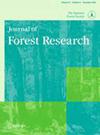Impact of forest type and age on shallow landslide susceptibility: a case study from the 2017 heavy rainfall in northern Kyushu, Japan
IF 1.1
4区 农林科学
Q3 FORESTRY
引用次数: 1
Abstract
ABSTRACT Assessing the impact of forest type and age on shallow landslide susceptibility is important for managing protective functions of forests. Previous studies have examined the correlation between forest types and ages, and shallow landslide susceptibility, but causal effects of forest type and age on shallow landslide susceptibility are yet not clear. This study investigated the causal effect of forest type and age on shallow landslide susceptibility using a propensity score method by combining existing geo-data sets. Here, we focus on shallow landslides caused by an extreme rainfall event on 5–6 July 2017, in the mountainous areas of Asakura City and Toho Village, Fukuoka Prefecture, Japan. Randomly located samples of coniferous forest, broadleaved forest, and young forest exposed to shallow landslide events were analyzed. The inverse probability of treatment weighting with the propensity score was applied to the samples to compare the differences in shallow landslide susceptibility among the three forest classes. Young forest had increased shallow landslide susceptibility, compared with coniferous forest and broadleaved forest, by 3.70 × 10−2 and 4.12 × 10−2, respectively, which corresponded to a two to three times increase in shallow landslide susceptibility when the forest changes from coniferous or broadleaved forest to young forest. No significant difference in shallow landslide susceptibility between coniferous forest and broadleaved forest was observed. These differences in shallow landslide susceptibility should be considered when implementing forest management schemes.森林类型和年龄对浅层滑坡易感性的影响——以2017年日本九州北部强降雨为例
本文章由计算机程序翻译,如有差异,请以英文原文为准。
求助全文
约1分钟内获得全文
求助全文
来源期刊

Journal of Forest Research
农林科学-林学
CiteScore
3.00
自引率
6.70%
发文量
62
审稿时长
3 months
期刊介绍:
Journal of Forest Research publishes original articles, reviews, and short communications. It covers all aspects of forest research, both basic and applied, with the aim of encouraging international communication between scientists in different fields who share a common interest in forest science.
 求助内容:
求助内容: 应助结果提醒方式:
应助结果提醒方式:


